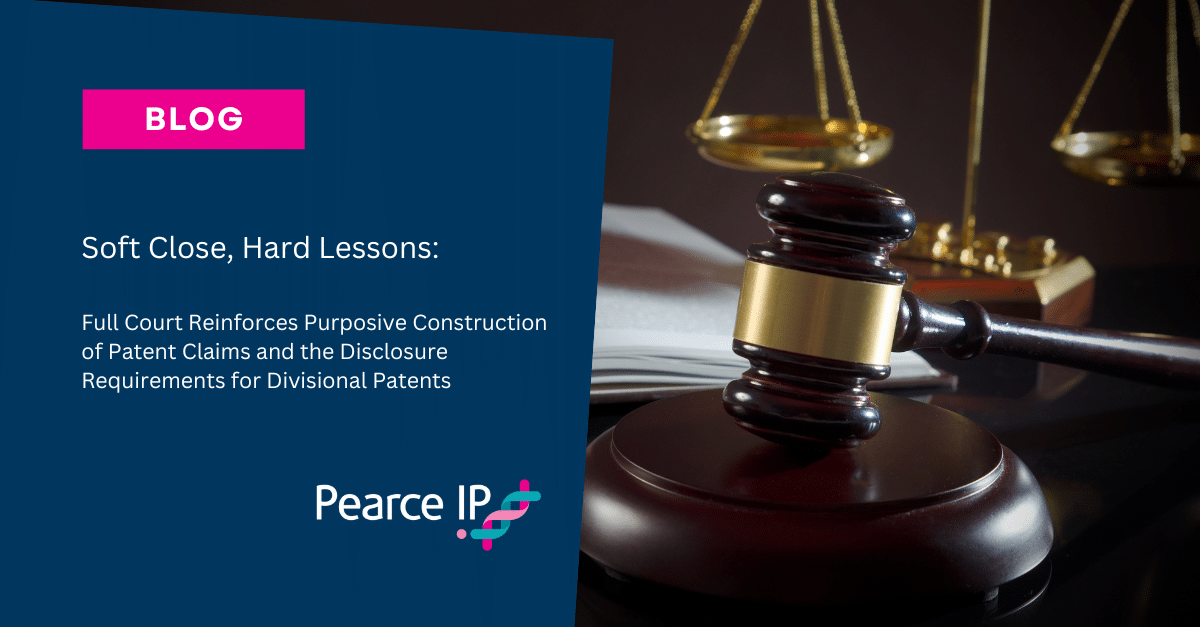| Date of decision: | 17 July 2024 |
| Body: | Full Court of the Federal Court of Australia |
| Adjudicators: | Yates, Charlesworth and Rofe JJ |
Background
This is an appeal from the first instance decision of Justice Burley in TCT Group Pty Ltd v Polaris IP Pty Ltd [2022] FCA 1493. The decision at first instance involved two innovation patents, AU2020100485 (the 485 Patent) and AU2020102918 (the 918 Patent), which relate to hinges for soft-closing glass panelled doors. Both patents are divisionals, and so claim priority from parent application 2017201858 (the Parent) filed three years earlier. This appeal concerned only the 918 Patent, owned by Polaris IP Pty Ltd (Polaris). Glass Hardware Australia Pty Ltd (Glass Hardware), the appellant, is the exclusive licensee. TCT Group Pty Ltd and Astral Hardware Pty Ltd (collectively TCT Group) marketed and sold hinges under the “Orion” brand in Australia before the divisional application for the 918 Patent was filed.
The primary judge, Justice Burley, found the 918 Patent infringed but held that:
- The 918 Patent was not entitled to claim priority from the Parent because the Parent did not disclose the invention claimed in the 918 Patent in a manner that was clear enough and complete enough for the invention to be performed by a person skilled in the relevant art (PSA). As a result, the 918 Patent claims were anticipated by the sale of the Orion hinges; and
- The specification of the 918 Patent also failed for insufficiency because it did not disclose the invention claimed in the 918 Patent in a manner that was clear enough and complete enough for the invention to be performed by a PSA.
On appeal, Glass Hardware raised three grounds:
- The proper construction of the invention disclosed in the Parent and the 918 Patent.
- Whether the 918 Patent claims disclose a “relevant range” requiring embodiments to be enabled across the scope of the range.
- If a relevant range exists, whether a PSA can make other embodiments without undue burden.
Glass Hardware needed to succeed on all grounds. As grounds two and three depended on ground one, failure on ground one would resolve the appeal.
Key Issues
Person Skilled in the Art
The parties agreed that the PSA was a “person engaged in, or who has experience in, the design of mechanical devices and, in particular, in respect of hinges used in domestic and commercial applications”. The experts called by the parties met this description (Mr Hunter for TCT Group and Mr Richardson for Glass Hardware).
Primary Judge’s Findings
Justice Burley construed claim 1 of the 918 Patent without limiting the dampener’s orientation or how it affects dampening upon closure of the hinge. His Honour held that the disputed integer, “striking surface to cooperate with the dampener”, encompassed a striking surface which interacted both directly and indirectly with the dampener to achieve the dampening effect. The Full Court summarised Justice Burley’s view as follows:
…the dampener must have a longitudinal axis disposed between, and substantially parallel with, planes defined by opposing faces of the first panel and be at least partially housed within the first insert component of the first leaf assembly.
Justice Burley observed that the Orion hinges were “actuated by a combination of interactions between several sliding surfaces external to the dampeners themselves”. On Justice Burley’s construction of claim 1, this indirect interaction between the dampener and the striking surface fell within the scope of the claim.
However, TCT Group argued that claim 1 of the 918 Patent was broader than the invention disclosed in the Parent (and the 918 Patent specification), which did not include dampeners functioning without direct contact. Justice Burley agreed. The Full Court summarised Justice Burley’s conclusion as follows:
…the specification of the Parent describes the invention by reference not only to the “co-planarity feature” but also by the limitation that the dampener comes into contact with the second leaf assembly, with the dampener arranged so that it is orthogonal or substantially orthogonal [i.e at right angles] to the hinge axis”
(emphasis added)
Justice Burley held that the requirement for the dampener to be oriented at right angles to the hinge axis addressed a problem arising from lateral forces applied to the dampener at other angles. Expert evidence indicated that changing the dampener angle would require a fundamental redesign and determining its feasibility would require a prototype to be built and tested. His Honour considered that this “left gaps in its teaching that must be filled by imaginative design work”.
Justice Burley also rejected Glass Hardware’s submission that the word “dampener” in the Parent meant a “dampener mechanism” for three reasons:
- A dampener is a component recognised in the field, which the expert evidence described as a component where a piston moves within a cylinder, its motion restricted by factors like friction or pressure.
- The specification supported the view that a PSA would understand a dampener to mean a specific component. The figures also depicted the dampener as a component, cooperating with a dampener body and dampener pin.
- Cross-examination of Mr Hunter revealed that he agreed that the ‘sliding cam’ could be regarded as a component of the “dampener mechanism”.
As a result, Justice Burley concluded that the 918 Patent was not entitled to claim priority from the Parent because the Parent did not disclose the invention claimed in the 918 Patent in a manner that was clear enough and complete enough for the invention to be performed by a PSA; and that the specification of the 918 Patent failed for insufficiency because it did not disclose the invention claimed in the 918 Patent in a manner that was clear enough and complete enough for the invention to be performed by a PSA.
Appeal submissions
Glass Hardware challenged Justice Burley’s decision on several fronts.
On the question of construction, Glass Hardware submitted that his Honour employed an “over-meticulous verbal analysis”, and argued for a more purposive construction with a “generous measure of common sense” such that the dampener mechanism in the Parent could function through both direct contact and indirect contact via an intermediate component. Glass Hardware contended that “coming into contact with” (in the Parent) shouldn’t exclude indirect contact, and that it was materially equivalent to the 918 Patent’s phrasing of “a striking surface to cooperate with the dampener”. Glass Hardware also took issue with the narrow interpretation of ‘dampener’, arguing it should include broader mechanisms achieving a dampening action.
Regarding sufficiency, Glass Hardware:
(i) Disputed the application of the “relevant range” concept described in Regeneron Pharmaceuticals Inc v Kymab Ltd [2020] RPC 22. Justice Burley found that “the angle of the dampener relative to the second leaf assembly is unlimited”, such that the 918 Patent claimed a range of dampener axis orientations from 0° to 360°. In Regeneron, the relevant claim was to a range of types of transgenic mouse, however, the PSA could only make some of the types of mice within that range. Glass Hardware sought to distinguish Regeneron on the basis that the claims of the 918 Patent employed a descriptive or functional language which “may well cover a variety of things”, and therefore did not evoke the notion of a “relevant range”;
(ii) Distinguished Jusand Nominees Pty Ltd v Rattlejack Innovations Pty Ltd (2023) 176 IPR 336, in which the Full Bench of the Federal Court had found that the range of materials that could be used was part of the invention’s ‘essence’ or ‘core’. Glass Hardware submitted that the innovative step in the 918 Patent related to the transmission of dampening forces within the same plane as the panel; and
(iii) Argued that a single example of a preferred embodiment of the invention could meet the disclosure requirement. In support, Glass Hardware cited the Explanatory Memorandum to the Intellectual Property Laws Amendment (Raising the Bar) Act 2012 (Cth) (the Explanatory Memorandum), which states:
A specification that provides a single example of the invention may satisfy the requirements, but only where the skilled person can extend the teaching of the specification to produce the invention across the full width of the claims, without undue burden, or the need for further invention.
In response, TCT Group submitted that the wider context of the Explanatory Memorandum provides further direction as to this requirement as follows:
However, it is expected to be more likely that, where the claims are broad, the specification will need to give a number of examples or describe alternative embodiments or variations extending over the full scope of the claims. This ensures that the monopoly extends only to that which could reasonably be said to be disclosed and no further.
Consideration
The Full Court emphasised that the 918 Patent would only be entitled to the Parent’s priority date if it clearly and completely disclosed the 918 Patent claims such that a PSA could perform the invention.
In their analysis, the Full Court noted that Glass Hardware did not challenge the primary judge’s construction of the “cooperate” integer in claim 1 of the 918 Patent (that it was not limited to direct contact between the dampener and the striking surface). The Full Court observed that “cooperate” was only found in the Summary of the 918 Patent describing the “first aspect” of the invention, but was not found in the Parent.
Applying a purposive construction, the Full Court agreed with Justice Burley’s observation that the language of the Parent was “unambiguous” and required the dampener to be oriented at right angles to the hinge axis and make direct contact with the second leaf assembly.
Relying on a joint expert report, the Full Court also agreed that “dampener” meant a component of a dampener mechanism. The Full Court observed that a “dampener” had a generally accepted definition and emphasised that this was not an instance where the patentee was attempting to describe a previously non-existent concept. This was consistent with the description in the Parent which showed the “dampener” as a component and not as an entire mechanism itself.
The Full Court also addressed Glass Hardware’s argument that Justice Burley applied inconsistent reasoning by construing “coming into contact” to exclude indirect contact, yet construed “orthogonal” to mean more or less at right angles per Catnic Components Ltd v Hill and Smith Ltd [1982] RPC 183. The Full Court observed that minor variations to the orthogonality (a few degrees either side) would not materially affect the invention’s function, whereas including indirect contact would fundamentally change how it worked.
In their concluding remarks, the Full Court stressed that while purposive construction and common sense are vital in patent construction, they cannot displace or override the clear ordinary meaning of words chosen by the patentee. They affirmed that Justice Burley had correctly given effect to the plain language without resorting to an “overly meticulous verbal analysis or purely literal construction”. The Full Court’s final message was clear:
Calling in aid a combination of purposive construction, together with the application of common sense, does not enable words deliberately chosen by the patentee to be broadened beyond their ordinary English meaning to expand the scope of the monopoly claimed (to what the patentee may have intended) in order to catch a creative alleged infringer, whilst maintaining priority from the earlier specification.
Outcome
The Full Court substantially agreed with Justice Burley’s decision, finding that:
- The 918 Patent was not entitled to claim priority from the Parent because the Parent did not disclose the invention claimed in the 918 Patent in a manner that was clear enough and complete enough for the invention to be performed by a PSA; and
- The specification of the 918 Patent also failed for insufficiency because it did not disclose the invention claimed in the 918 Patent in a manner that was clear enough and complete enough for the invention to be performed by a PSA.
The Full Court dismissed the appeal with costs.
Implications
The Full Court’s decision emphasises that:
- Unlike many other countries, Australia does not have a doctrine of equivalents. While purposive construction and common sense are integral to patent construction, they cannot broaden the scope of the monopoly claimed by expanding or overriding the clear and ordinary meaning of words deliberately chosen by the patentee.
- Technical terms will be construed in light of their meaning as understood by a PSA. If a technical term is to be given a different meaning, then the specification will need to provide a clear definition of that term as it is to be understood in the context of the patent.
- To rely on a parent application’s priority date, the invention claimed in the divisional application must be clearly and completely disclosed in the parent. Patentees should be cautious about using different terminology in divisional applications from that used in the parent application, and avoid broader language that may extend beyond the scope of the parent. Similarly, the invention claimed in the patent must be enabled by the disclosure in the specification, that is, the specification must disclose the claimed invention in a manner that is clear enough and complete enough for the invention to be performed by a PSA.
About Pearce IP
Pearce IP is a specialist firm offering intellectual property specialist lawyers and attorneys with a focus on the life sciences industries. Pearce IP and its leaders are ranked in every notable legal directory for legal, patent and trade mark excellence, including: Chambers & Partners, Legal 500, IAM Patent 1000, IAM Strategy 300, MIP IP Stars, Doyles Guide, WTR 1000, Best Lawyers, WIPR Leaders, 5 Star IP Lawyers, among others.
In 2025, Pearce IP was recognised by Australasian Lawyer and New Zealand Lawyer’s 5 Star Employer of Choice, and is the “Standout Winner” for inclusion and culture for firms with less than 100 employees. Pearce IP was awarded “IP Team of the Year” by Lawyers Weekly at the 2021 Australian Law Awards. Pearce IP is recognised by Managing IP as the only leading ANZ IP firm with a female founder, and is certified by WEConnect International as women owned.

Naomi Pearce
CEO, Executive Lawyer (AU, NZ), Patent Attorney (AU, NZ) & Trade Mark Attorney (AU)
Naomi is the founder of Pearce IP, and is one of Australia’s leading IP practitioners. Naomi is a market leading, strategic, commercially astute, patent lawyer, patent attorney and trade mark attorney, with over 25 years’ experience, and a background in molecular biology/biochemistry. Ranked in virtually every notable legal directory, highly regarded by peers and clients, with a background in molecular biology, Naomi is renown for her successful and elegant IP/legal strategies.
Among other awards, Naomi is ranked in Chambers, IAM Patent 1000, IAM Strategy 300, is a MIP “Patent Star”, and is recognised as a WIPR Leader for patents and trade marks. Naomi is the 2023 Lawyers Weekly “IP Partner of the Year”, the 2022 Lexology client choice award recipient for Life Sciences, the 2022 Asia Pacific Women in Business Law “Patent Lawyer of the Year” and the 2021 Lawyers Weekly Women in Law SME “Partner of the Year”. Naomi is the founder of Pearce IP, which commenced in 2017 and won 2021 “IP Team of the Year” at the Australian Law Awards.

Helen Macpherson
Executive, Lawyer (Head of Litigation –Australia)
Helen is a highly regarded intellectual property specialist and industry leader with more than 25 years’ experience advising on patents, plant breeder’s rights, trade marks, copyright and confidential information. She is known for her expertise in complex, high-value patent matters and leverages her technical background in biochemistry and molecular biology to work across a wide range of technologies, including inorganic, organic, physical and process chemistry, biochemistry, biotechnology (including genetics, molecular biology and virology), and physics. Helen is an active member of the Intellectual Property Committee of the Law Council of Australia and the Intellectual Property Society of Australia and New Zealand.

Nathan Kan
Lawyer
Nathan is a lawyer specialising in life sciences, providing legal advice and litigation support across intellectual property and commercial disputes. He is passionate about the intersection of law and science, and during his time with the Science and Technology Law Association at the University of Melbourne, he helped lead events, workshops and publications across STEM fields including life sciences, AI and digital transformation.

